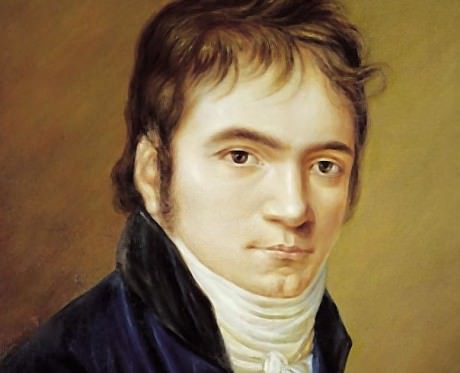Everybody knows about Walter Cronkite and his impact on television news. Fewer people remember or know about Cronkite’s great rival on NBC during the 1960s, The Huntley-Brinkley Report. Pairing the dour Chet Huntley with the droll David Brinkley, the show featured the two anchormen batting news segments back and forth until they’d end the half-hour broadcast with Huntley saying “Good night, David,” Brinkley responding “Good night, Chet,” and Huntley intoning into the camera, “And good night for NBC News.”
And then, as if to reinforce the world-shattering impact of everything they had just reported, the following music would play as the credits rolled:
And thus the second movement of Ludwig van Beethoven’s Symphony No. 9 became part of the sound of America even in an era more associated with countercultural revolution and rock ‘n’ roll. In employing Beethoven’s Ninth, NBC added to an endless list of symbolic uses for an epic composition considered by many the greatest piece of music ever written.
In 2015, Beethoven’s Ninth hits Washington like the storm it presents to the world before transforming into a utopian finale that adds four solo singers and a chorus singing the German poem “Ode to Joy” by Friedrich Schiller. Five combinations of orchestras and choruses in our region will perform Beethoven’s Ninth between January and May, starting this coming weekend. The groups, their dates and their venues:
- The Baltimore Symphony Orchestra with the Baltimore Choral Arts Society, Saturday, January 3, 2015 at The Music Center at Strathmore
- The National Philharmonic Orchestra & Chorale, Sunday, February 8, 2015 also at The Music Center at Strathmore, in a special 10th anniversary concert commemorating the group’s concerts at Strathmore
- The Charlottesville Symphony with The Oratorio Society of Virginia and the University of Virginia’s University Singers, Saturday and Sunday, April 18 and 19, 2015 at two different venues in Charlottesville
- The McLean Orchestra with the Metropolitan Chorus, Saturday, May 9, 2015 at the Oakcrest School in McLean
- The Alexandria Symphony Orchestra, also with the Metropolitan Chorus as well as the Heritage Signature Chorale, Saturday, May 16, 2015 at the Rachel M. Schlesinger Concert Hall on the campus of NOVA Alexandria
These complete performances of Beethoven’s Ninth are bound to be a revelation for many, taking the symphony, especially its played and sung fourth movement, beyond its many cultural reference points.
If the lyrics “Joyful, joyful, we adore thee” call up a tune in your head, that’s because the melody is the fourth movement of Beethoven’s Ninth transformed into an English hymn sung in many American churches for the past hundred years. In Europe, the Ode to Joy theme is the official anthem of the European Union. In Japan, Beethoven’s Ninth has a fanatical following and its full performance (which usually takes one hour and five or ten minutes) is a New Year’s tradition. In America, when flash mobs were a “thing” for a few years, once again Beethoven’s Ninth was the single most common classical music choice for these spontaneous performances.
Still, if you’ve never really heard Beethoven’s Ninth and you go to one of these concerts, you should know that it’s completely up to you whether you actually like it or not. What’s striking about Beethoven’s Ninth is not so much that some people like some parts and other people like other parts. It’s that the same effects in it that many people adore, many other people dislike or even detest. It’s like a reflecting ball whose light can be refracted a thousand different ways.
For example, the first movement begins uniquely, and to many ears, brilliantly, with what for all the world sounds like an imitation of the orchestra tuning up before settling on the key of D minor. But the rest of the movement, while continuing in a dark and foreboding mood, never quite seems to present a fully formed melody. Is that an effective table-setter to the drama ahead or a slog to sit through? You decide.

The second movement (the Huntley-Brinkley theme) is a spectacular spinning wheel of instruments progressively entering on the same basic rhythmic figure, rising in volume, and then withdrawing in favor of some other instrument or section that had meanwhile entered the fray – all before they magically gather together in several climaxes. But some people feel that Beethoven overdid the use of timpani introduced at the top of the movement to try to create additional dramatic effect. (I don’t, I love it – so there.) The calmer, more lyrical third movement is a wonderful respite for many, but a pedantic sort of theme-and-variations for others.
The fourth movement with the chorus is replete with controversy. The very first beat is a gigantic clash of notes which, if nothing else, serves to wake up (and probably alarm) anyone in the audience who may have fallen asleep. Early in the movement the basic theme of each of the previous three movements briefly appears before being roughly overridden and rejected by the cellos and basses. Clever or annoying? Your call. The lyrics when the singers begin about five minutes in have been variously called brilliant, spiritual, trite and disturbing, and their repetition in various ways by Beethoven, with multiple sudden swells, rapid fadeaways, and roundabout harmonies against very high soprano notes can be fresh and surprising or tedious.
At one notorious point, the singing and playing basically stops and then restarts with marching notes that begin in the bassoon, then adding additional woodwind instruments, then drums and a tinkly triangle along with the rest of the orchestra in what at the time was considered a so-called “Turkish” theme. To some this represents the beginning of the final, glorious “joy” of the symphony, completing the journey from its severely dark opening. To others it’s simply bizarre. (My own reaction when I hear this: “How did a high school marching band get into a Beethoven symphony?”) In any case, from there the solo singers and the chorus basically sing their guts out. By the end of the piece all subtlety has been expunged.
If it helps, remember three things as you hear and see this piece performed: 1) the original standard length of a CD, 74 minutes, was set largely if not entirely because the chairman of Sony wanted to ensure that any recording of Beethoven’s Ninth, which has been known to run as long as 1:14, could fit; 2) adding vocals to a symphony was a shocking innovation in 1824 but since has been repeated many times by many composers; 3) Beethoven was deaf when he made this stuff up, which is absolutely incredible to ponder. Kudos to the various orchestras and choruses who are taking on Beethoven’s Ninth in live performance. Our region is all the richer for it.
https://youtu.be/a97EG7Mqp8g
https://youtu.be/fXRtM_TjK3E




